Ehoumaki (ehou maki): Lucky long sushi roll for Setsubun no hi
(Another one from the archives. Today (February 3rd) is once again Setsubun no hi. Unfortunately, what with trying pack up the house by the end of month when we are moving, and the Bento Challenge going on over at Just Bento, I haven't had much time to do post-worthy cooking for Just Hungry. But some should come... In the meantime, if you want to eat a big whole sushi roll for luck today, here's how!
This year's ehou (lucky direction) is a bit to the right of East-North-East. While I'm at it, here are the ehou for the next four years:
- 2009 - East-North-East
- 2010 - West-South-West
- 2011 - South-South-East
- 2012 - North-North-West ....
- 2015 - West-South-West
Enjoy your ehou maki! Originally published February 1, 2008.)
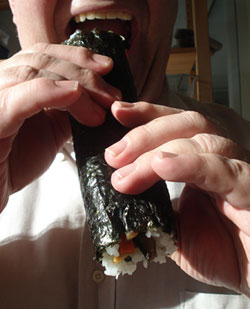 This year, setsubun no hi (節分の日) falls on the 3rd of February (some years it's on the 4th). It marks the start of the spring season or risshun (立春) in Japan according to the old lunar calendar. It's not an official national holiday, but it is celebrated in ways all meant to drive away bad luck and bring in new, good luck. Most of the traditional rituals revolve around beans, because beans are considered to be very lucky. But there is another way of celebrating setsubun no hi, and that's with a big, long, uncut sushi roll called ehou-maki.
This year, setsubun no hi (節分の日) falls on the 3rd of February (some years it's on the 4th). It marks the start of the spring season or risshun (立春) in Japan according to the old lunar calendar. It's not an official national holiday, but it is celebrated in ways all meant to drive away bad luck and bring in new, good luck. Most of the traditional rituals revolve around beans, because beans are considered to be very lucky. But there is another way of celebrating setsubun no hi, and that's with a big, long, uncut sushi roll called ehou-maki.
I grew up in and around the Kanto region, which is the area around Tokyo, so I didn't know about ehou-maki ((恵方巻き)growing up, because it's a Kansai region (the area around Osaka and Kyoto) custom for setsubun no hi. Nowadays though the ehou-maki tradition has become popular nationwide. They are sold everywhere, especially at convenience stores, who take this as an opportunity to get people to celebrate, buy and eat in that awkward gap in between New Year's feasting and Valentine's Day chocolate gorging.
[Edit: ehou is pronounced eh-hoe by the way, not ee-haw.]
This made me react in So, what makes an ehou-maki different from a regular sushi roll? There are basically three rules:
- It must contain seven ingredients, because seven is a lucky number.
- It must not be cut, because it might cut (off) your luck.
- You have to eat it while facing the lucky direction, which changes every year! This year's lucky directly is hinoe (丙 (ひのえ)), which is a little bit to the south of south-south-east on a regular compass. If you can read kanji, this page has a good chart.
- Finally, you must eat the whole roll in total silence.
A seven-ingredient sushi roll is basically a futomaki, or fat sushi roll, and that is what the directions are for. I've suggested several filling variations.
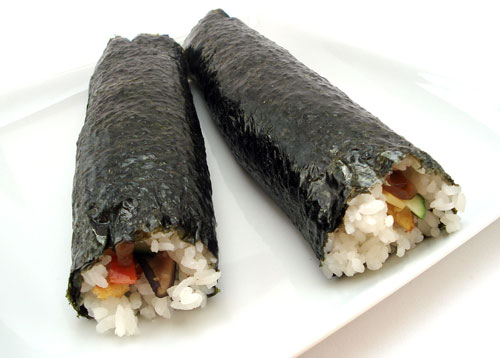
Last year, the Superbowl fell right on Setsubun no hi, so there's a New York-Boston (remember it was the Giants vs.Patriots or something) filling combo below. This year, I guess the Cardinals were out of luck, ehou-maki wise. (What would have been a good Pittsburgh-themed sushi roll filling?)
You can of course order a regular futomaki from your favorite sushi takeout, and ask them to put in seven ingredients and to not cut it. Then on Sunday, face the right away, and solemnly eat your roll in total silence.
You can of course order a regular futomaki from your favorite sushi takeout, and ask them to put in seven ingredients and to not cut it. Then on Sunday, face the right away, and solemnly eat your roll in total silence.
Ehou-maki, lucky seven-ingredient sushi roll
The ingredients for one roll. Increase proportionately according to the number you want to make.
- A bit less than 1 1/2 cups (about 300ml) prepared sushi rice
- 1 sheet of nori seeweed
- Seven ingredients of your choice - see below for suggestions
Equipment needed:
- a sushi rolling mat. In a pinch it is possible to roll a sushi roll with plastic wrap and so on, but for futomaki the support given by a sushi rolling mat is pretty useful. Besides, they are quite cheap and available at any Japanese or Asian grocery these days.
- a bowl of cold water with a little vinegar (sumizu). This is used to wet your hands, rice scooper and other utensils, to keep rice grains from sticking.
Rolling a big fat maki
Put the nori sheet, shiny-slick side down, on your sushi rolling mat.
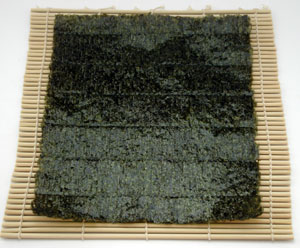
Spread about 1 1/2 cups (lightly packed into cup; don't smoosh down!) of sushi rice evenly over the nori, leaving about a half inch or 1 cm gap on the far side. Use your fingers dipped in the bowl of vinegar water to spread out the rice.
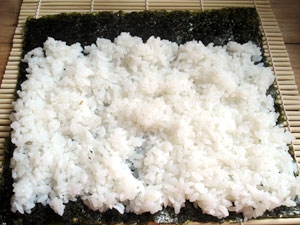
Pile up your filling in the middle of the rice. Don't try to pile on too much here if you are a beginner.
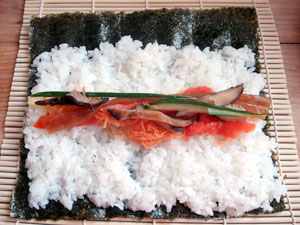
Grab the near end of the sushi rolling mat to start rolling. You may need to reach around with your fingers to keep the filling in place.
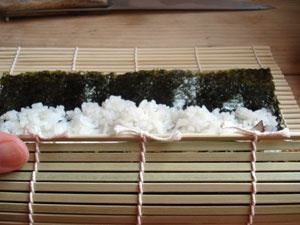
Roll over the filling in one go - stopping in the middle will make for a messy roll. Squeeze tightly, and finish rolling.
Unroll. (Practice does help, so do over if your first one didn't work.) If the roll looks a bit uneven, gently squeeze again to even out.
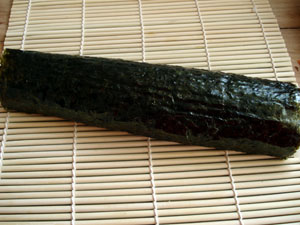
Optionally serve with wasabi and soy sauce for dipping.
Remember that for a ehou maki you must not cut the roll. But if you're making a futomaki for a regular day, cut off the ragged ends (which go in your mouth) and cut the rest into 5 or 6 even pieces. Having a very sharp knife and wetting the blade before cutting helps.
Lucky seven ingredient combination ideas
Traditional Japanese
All ingredients can be bought at a well stocked Japanese grocery store.
- 1 dried shiitake mushroom, soaked in water until softened, then cooked in 2 cups of the soaking liquid with added 2T mirin, 1/2 cup soy sauce, and 3T sugar until very tender (about 20 minutes or more)
- 1 piece of kanpyou or dried gourd strip, soaked in water until soft, and cooked with the shiitake. Larger Japanese groceries like Mitsuwa often have precooked kanpyou - look in the refrigerated section.
- Tamagoyaki or usuyaki tamago (Japanese style omelette)
- A small piece of sushi-grade tuna or other sushi-grade fish, cut into thin strips
- Some denbu (でんぶ)- pink flaked cod - found in the refrigerator section. It looks like bright pink fluff (the bright pink comes from food coloring, if that concerns you)
- Grilled anago eel (kabayaki, 蒲焼き), cut into thin strips - found in the freezer section usually
- Thin stick of cucumber
The fillings I used
This rather turned into a Japanese meets Swiss sort of combo. It tasted good!
- 1 dried shiitake mushroom, cooked as above
- Kanpyou, cooked with the shiitake as above
- Finely julienned carrots
- Smoked salmon (could not get sushi-grade tuna!)
- Datemaki - a fish-egg combo tamagoyaki. I'll give the recipe for this very soon, but you can use tamagoyaki instead. Datemaki is often sold at Japanese groceries (it looks like a bright yellow rolled cake), so you can use that instead.
- Thinly julienned cucumber
- A mild local cheese called Bachtel-Stei. You could use something like Monterey Jack or Fontina.
A vegan combo
- Shiitake
- Kanpyou, both cooked as above.
- carrots cut into sticks and cooked with the shiitake briefly
- Thin fried tofu (aburaage), blanched in hot water then cooked with the shiitake. You could also use prepared inari zushi skins.
- Blanched and slivered green beans
- Blanched and well squeezed out spinach
- Thin stick of cucumber
A New York/Boston combo for Super Bowl Sunday
If you want your team to win, make sure you're facing the right way when you eat the roll, and don't say a word!
- Smoked salmon or better yet, belly lox
- Cream cheese mixed with mayonnaise
- Thin stick of cucumber
- Chopped cooked lobster (or, imitation crab sticks if you are on a budget)
- Finely chopped chives
- Thinly julienned pickled jalapeno peppers
- Boston lettuce, cut into long thin strips
Ham and cheese combo
Almost like a Subway sandwich in a sushi roll.
- Julienned boiled ham...or even spam, maybe
- Avocado, cut into thin strips
- Thinly julienned cucumber
- Cream cheese
- Thinly julienned pickles
- Shredded iceberg lettuce
- A couple of watercress sprigs
The Mediterranean combo
- Cooked and flaked salt cod
- Mayonnaise
- Finely chopped olives
- Boiled shrimp, finely chopped
- Salt-cured anchovies, de-salinated a bit
- Toasted pine nuts
- Arugula
The poor student's combo
- Canned tuna mixed with mayonnaise
- Finely chopped hardboiled egg
- Thinly sliced onions, sprinkled with a little salt and massaged to soften, then drained
- Thinly julienned carrots
- Thinly julienned cucumber
- Shredded lettuce, any kind
- A few capers or chopped up pickle
Think up your own combinations! Just come up to seven and your karma factor is set.
Here is a TV reporter eating an ehou maki in Times Square:
And here is some dude dressed up as Homer Simpson eating an ehou maki:
More about setsubun
The way we celebrated setsubun when I was growing up was with beans. We'd go to a nearby jinja or Shinto shrine (Buddhist temples also do this), where the priests would throw toasted soybeans wrapped in paper at the crowd while everyone yelled oni wa soto, fuku wa uchi! (Demons outside, luck inside!) Traditionally you are supposed to eat as many beans as your age, but the paper-wrapped beans often had about 10 to 12 beans. So, when as a 10 year old I ate 10 packets of beans, I got quite a tummy ache. Depending on the shrine or temple, the priests also throw little gifts at the crowd, and that can make things a bit scary as everyone shoves and pushes to grab them! I never caught a gift but I did get hit square in the face with something hard once at one of those things.
As I said earlier, ehou-maki is really a Kansai tradition. In the Kanto area the only real food tradition associated with setsubun is those toasted beans. Basically, raw soybeans are slowly roasted until they are crunchy and edible. Nowadays, peanuts are often substituted for the toasted beans. Some families might make some _osekihan_, azuki (adzuki) beans and rice which is a sort of an all-occasion celebratory dish.
A final way of celebrating setsubun no hi is to take a nice long relaxing bath, with some slices of yuzu in the water. Bathing in hot yuzu-infused water is supposed to get rid of bad spirits. At least it smells nice! In Japan you can get bath essences with yuzu oil. I'm guessing that theoretically any citrus would work, but who am I to try to play with old superstitions.
Here's the Wikipedia entry on _setsubun no hi_.
See also
- How to make plain Japanese style rice and sushi rice
- Hamaguri zushi, dainty shell-shaped sushi eaten on Girl's Day on March 3rd
- Botamochi, sweet bean cakes eaten around the spring equinox
- Osekihan, festive Japanese beans and rice
- All sushi recipes on Just Hungry
If you enjoyed this article, please consider becoming my patron via Patreon. ^_^

 Welcome to Just Hungry, where we serve authentic Japanese recipes and more! I'm
Welcome to Just Hungry, where we serve authentic Japanese recipes and more! I'm 













Comments
santos.
1 February, 2008 - 15:45
Permalink
i love it! so totally doing
i love it! so totally doing this this year. happy new year!
maki
1 February, 2008 - 16:14
Permalink
happy new year
happy new year to to you too santos!
anon.
1 February, 2008 - 16:43
Permalink
I was thinking about sushi
I was thinking about sushi for my Super Bowl party, and these would be perfect. Great timing Thx! (the guy with the roll looks hungry, lol)
Hillary
1 February, 2008 - 18:11
Permalink
Gorgeous!
That is one gorgeous sushi hand roll! Nice!
HcF
1 February, 2008 - 19:07
Permalink
Thank you!
Thanks for including the "Poor Student's Combo"! (^_^) The university that I go to is located in a pretty remote area so it's really hard finding Asian foods. But I am definitely trying this out this Sunday! Thank you!
Veriest
3 February, 2009 - 08:37
Permalink
Re: Thank you!
Thank you as well for including the "Poor Student's Combo"! It looks delicious as well, though a bag of dehydrated shiitake mushrooms shouldn't be beyond the means of your average college kid on a budget.
silver.
3 February, 2009 - 14:04
Permalink
Re: Thank you!
Depends on the place, I guess. Dried shiitake mushrooms are super-expensive here. =/
aforkfulofspaghetti
1 February, 2008 - 20:01
Permalink
How fantastic! And what a
How fantastic! And what a great explanation of (a) what it is, and how to make one...
I'd have no problem eating in silence - I'd be too busy just enjoying it to want to talk at the same time!
Happy Setsubun no hi for the 4th!
Kim
2 February, 2008 - 02:30
Permalink
Looks like Kimbap!
When I first saw it, I thought Kimbap! It looks just like it. Except Kimbap is usually eaten sliced and is a popular lunch item in Korea. The traditional Kimbap has 7 ingredients: spinach, egg, beef, crab, pickled daikon, cucumber, and carrot.
treehuggermums
2 February, 2008 - 12:37
Permalink
Oh yum!!
That looks fab! I've never actually made sushi myself, but I'm very tempted to finally give it a go.
Have a good day tomorrow!
y
2 February, 2008 - 17:45
Permalink
lol. I love that you
lol. I love that you included the poor student version (i'm on a grad student salary)
I'm also from Kanto, and I too noticed that convenience stores totally took advantage of this Kansai custom to sell those rolls.. clever!
I was considering making rolls for the Superbowl party my friend is hosting, but 101 cookbook's artichoke dip (with tofu) sounds too good... can't decide!
basak
3 February, 2008 - 18:58
Permalink
Thanks a lot!
We've had ours today for dinner, in silence. I've used what i had on hand, so it ended up being an interesting roll. As filling, I used mushrooms (white, dry-fried), carrots, tiny broccoli florets, roasted red peppers, tuna (not sushi grade, so i briefly cooked it), dried crispy onions and some tsubuan that i made two days ago following your instructions. Tsubuan may not sound like it suits the rest but my batch had turned out to be very subtly sweet and it worked beautifully in this roll. I've made an extra roll which will be cut and become tomorrow's bento. It was, of course, meditative and we enjoyed our moment of hoping for luck. Thank you for introducing this to me and may luck be with you, too.
MadSilence
4 February, 2008 - 01:38
Permalink
Demons out! Luck in!
Thanks for the detailed ehou maki instructions. Living in Kanazawa I've grown to love sushi.
Demons out! Luck in! 鬼は外! 福は内!
http://madsilence.wordpress.com/
MadSilence
erisgrrrl
3 February, 2009 - 03:24
Permalink
Re: Ehou maki: Lucky long sushi roll for Setsubun no hi
"But if you’re making a futomaki for a regular day, cut off the ragged ends (which go in your mouth)"
HA! We call those ends "sushi butts" and they do indeed go in your mouth!!! :D
pii_bii
3 February, 2009 - 09:37
Permalink
Re: Ehou maki: Lucky long sushi roll for Setsubun no hi
[quote=erisgrrrl])We call those ends "sushi butts" and they do indeed go in your mouth!!! :D[/quote]
I like 'sushi butts'; nice expression. I think those are the perks the sushi maker gets to enjoy for all his/her hard labour! They'd only go to waste if they didn't into me! :)
As for the ehou maki, I've often wanted to eat a whole sushi roll un-cut, like a sausage roll... and now I can, without feeling (too) greedy! It's a tradition, after all. :)
Sile
3 February, 2009 - 22:29
Permalink
Re: Ehou maki: Lucky long sushi roll for Setsubun no hi
Maki, I really love hearing/reading about food traditions etc around "holidays"... Will you be doing more of these? :D
erisgrrrl
4 February, 2009 - 03:37
Permalink
Re: Ehou maki: Lucky long sushi roll for Setsubun no hi
I made ehou maki today for Setsubun and even ate it facing the proper direction and in silence. We used sesame seeds, carrot, cucumber, cream cheese, green onion, k-rab and slices of inari skins. Thanks for the info on the tradition- it was fun to be Japanese for 5 minutes ;-)
And in reference to phii_bii's lust for uncut sushi rolls - our 4yo will grab an unsliced roll and gnaw away any chance he gets!!! :D
TAKA
4 February, 2009 - 05:59
Permalink
Re: Ehou maki: Lucky long sushi roll for Setsubun no hi
Wow, so nice article!
Yesterday, I throw away beans with my family and ate very big sushiroll with wasabi.
pii_bii
4 February, 2009 - 17:15
Permalink
Re: Ehou maki: Lucky long sushi roll for Setsubun no hi
I did make this yesterday, and it was more of a challenge to eat than I thought it would be - it turned out as quite a fat roll, probably due to lack of skill on my part! I ate in silence, but I'm not sure if I was facing ENE, as I was getting distracted by Masterchef on the TV...:)
Maegan
5 February, 2009 - 23:42
Permalink
Re: Ehou maki: Lucky long sushi roll for Setsubun no hi
I haven't lived in Pittsburgh for very long, am not a pro football fan, and don't believe in good luck...but here's a go at a Steelers filling.
-pastrami (a nod to Primanti that would add a note of black pepper)
-a good coleslaw with vinegar dressing
-boiled potatoes lightly coated with mayo (because I don't think french fries would work in a sushi roll:)
-smoked salmon or steamed shrimp ( Pittsburgh's loves seafood)
-chiffonade of fresh basil (there seems to be a proud Italian population here with many homestyle Italian restaurants)
-and lastly, good quality lettuce & thinly sliced tomatoes to celebrate the "gentrification" of many parts of the city that of course includes farmers' markets:)
Liz
8 February, 2009 - 23:58
Permalink
Re: Ehou maki: Lucky long sushi roll for Setsubun no hi
Thanks for the great suggestions for fillings, as well as the cultural lesson!
Moniiku_Asami95
27 September, 2009 - 05:54
Permalink
Re: Ehoumaki (ehou maki): Lucky long sushi roll for ...
Wow, it looks "Oh so" delish!
I can just taste it!
*Nom Nom* :3
You are blue sooo am i!!
My baby is blue soo am i!!
Meltlet
23 July, 2010 - 22:17
Permalink
Re: Ehoumaki (ehou maki): Lucky long sushi roll for ...
It's impossible to read your posts without laughing XD I say this as a compliment!
nyginko
8 February, 2011 - 01:38
Permalink
Re: Ehoumaki (ehou maki): Lucky long sushi roll for ...
Maki, thanks for these wonderful explanations. What a richness in these rituals at the time of the seasonal changes!
I can feel the time of change within, but also have seen signs of the changes in my citrus trees, two of them started from seeds of middle eastern fruits called "etrogs." These have formed at least a dozen blossoms! (I had brought these plants in their pots indoors to avoid the frost about two months ago. Usually they are on my east south facing balcony.) Last year they blossomed while outdoors (their scent is marvelous) and formed fruits. Now I know it is a good time to make ehou maki, too! And green peas and lettuce! And noodles (I brought home a pkg of japanese soba from the supermarket yesterday.)
How wonderful that we still can tell the stories of these
wondderful customs and rituals that have come down to us through thousands of years. Yes?
nyginko/usa